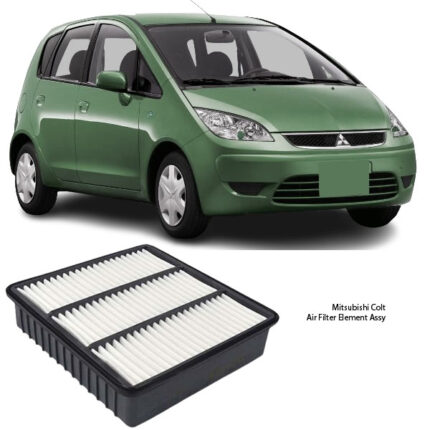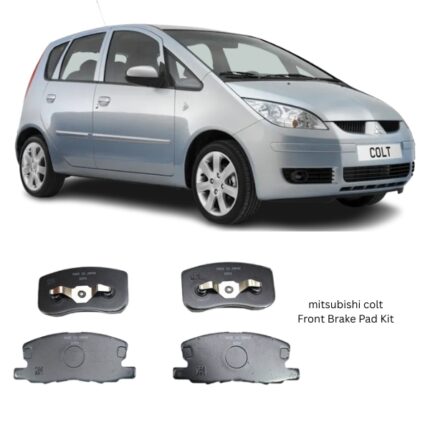Get Mitsubishi Colt Front Brake Pad Kit D6121 in Kenya
A Front Brake Pad Kit is a critical component of any vehicle’s braking system. Designed to provide reliable and efficient stopping power, the front brake pads are positioned within the brake calipers and work by pressing against the brake discs (also known as rotors) to slow or stop the vehicle. As part of a disc brake system, front brake pads undergo immense stress and heat every time a vehicle decelerates, which makes their material composition, fitment, and design quality essential for safety and performance.
Function of the Front Brake Pad Kit
The main function of the front brake pad kit is to create the friction necessary to bring a vehicle to a stop. This is achieved through the application of hydraulic pressure from the brake caliper, which forces the brake pads against the spinning brake discs. The resulting friction converts kinetic energy into thermal energy (heat), thereby reducing the vehicle’s speed or stopping it altogether.
Because the front brakes typically handle a larger share of the braking force—especially in front-engine vehicles where more weight is distributed over the front wheels—the front brake pads tend to wear faster than the rear ones and need regular inspection and replacement.
Components of a Front Brake Pad Kit
A complete front brake pad kit typically includes the following:
-
Two Pairs of Brake Pads – One pair for each front wheel.
-
Anti-Rattle Clips/Shims – These help reduce noise and vibrations during braking.
-
Brake Wear Indicators (if applicable) – These can be mechanical or electronic, and alert the driver when pads need replacement.
-
Fitting Accessories – Such as bolts or lubricant for easy installation and optimal performance.
The kit is designed to ensure compatibility, easy installation, and reliable braking, making it suitable for professional workshops and DIY users alike.
Construction and Materials
Brake pads are made of high-friction materials bonded to a metal backing plate. The quality and type of friction material can vary based on intended usage and vehicle type. The common types include:
-
Semi-Metallic – Durable and good at heat dissipation, but may be noisier and generate more dust.
-
Ceramic – Offer quieter operation, less dust, and longer lifespan, but typically cost more.
-
Organic/Non-Asbestos Organic (NAO) – Made from materials like rubber, glass, and resin; softer and quieter but wear faster.
The backing plate is engineered to resist warping and serves as the structure that holds the friction material in place. Some brake pads also feature slots and chamfers to minimize noise, resist cracking, and manage heat buildup during aggressive braking.
Performance Characteristics
Key performance attributes of a front brake pad kit include:
-
Friction Coefficient: Determines how much stopping power the pads provide. A consistent friction coefficient ensures smooth braking at various speeds and temperatures.
-
Heat Resistance: High-quality pads resist brake fade caused by heat buildup.
-
Noise Reduction: Advanced shims, chamfers, and slotting reduce brake squeal.
-
Durability: The lifespan depends on material type, driving habits, and operating conditions.
Premium brake pads are designed to offer a balance between performance, comfort, and longevity. Some performance pads may sacrifice comfort (noise/dust) for higher friction levels suitable for spirited driving or heavy-duty applications.
Signs That Front Brake Pads Need Replacement
Regular inspection is crucial to ensure the effectiveness of the brake system. Signs that your front brake pads may need replacement include:
-
Squeaking or Squealing Noise: This usually indicates worn pads or the built-in wear indicator contacting the rotor.
-
Grinding Noise: Suggests that the pads are completely worn, and metal is contacting metal, which can damage the rotors.
-
Longer Stopping Distance: A noticeable delay in braking responsiveness.
-
Vibration or Pulsation: May indicate uneven pad wear or warped rotors.
-
Brake Warning Light: Some vehicles have sensors that alert the driver when the pads are thin.
It is generally recommended to replace the front brake pads every 30,000 to 70,000 kilometers, depending on usage and manufacturer guidelines.
Installation and Fitment
A front brake pad kit is typically designed to fit specific vehicle models, ensuring proper alignment with the caliper and rotor. When installing the kit, the following steps are generally followed:
-
Lift and Secure the Vehicle – Use jack stands for safety.
-
Remove the Wheel – Expose the braking system.
-
Remove the Caliper – Secure it without stressing the brake hose.
-
Remove Old Pads and Hardware – Clean the caliper bracket and rotor surface.
-
Install New Pads and Accessories – Apply lubricant where necessary.
-
Reinstall the Caliper and Wheel – Torque bolts to manufacturer specs.
-
Bed-In the New Pads – Follow a specific procedure to transfer an even layer of friction material onto the rotor.
Proper bedding-in helps improve braking efficiency and prevent noise or premature wear.
Maintenance Tips
To ensure maximum performance and lifespan of front brake pads:
-
Check pad thickness during regular vehicle service intervals.
-
Avoid aggressive braking unless necessary.
-
Replace both pads on each axle simultaneously.
-
Monitor brake fluid level, as it can drop when pads wear.
-
Clean caliper slides and replace hardware when changing pads.
Routine inspections, especially before long trips or after driving in extreme conditions (such as water, mud, or high heat), are essential.
Benefits of a Quality Front Brake Pad Kit
Choosing a high-quality front brake pad kit offers numerous benefits:
-
Improved Safety – Reliable stopping power enhances overall vehicle safety.
-
Enhanced Comfort – Quiet, smooth braking improves the driving experience.
-
Cost Efficiency – Reduces rotor wear and extends the lifespan of related components.
-
Consistent Performance – Better control in both normal and emergency braking situations.
-
Ease of Installation – Kits are designed for quick and straightforward installation.
When sourced from a reputable supplier, a front brake pad kit meets or exceeds original equipment specifications, ensuring proper function and performance.
Follow us on Facebook for more parts.




